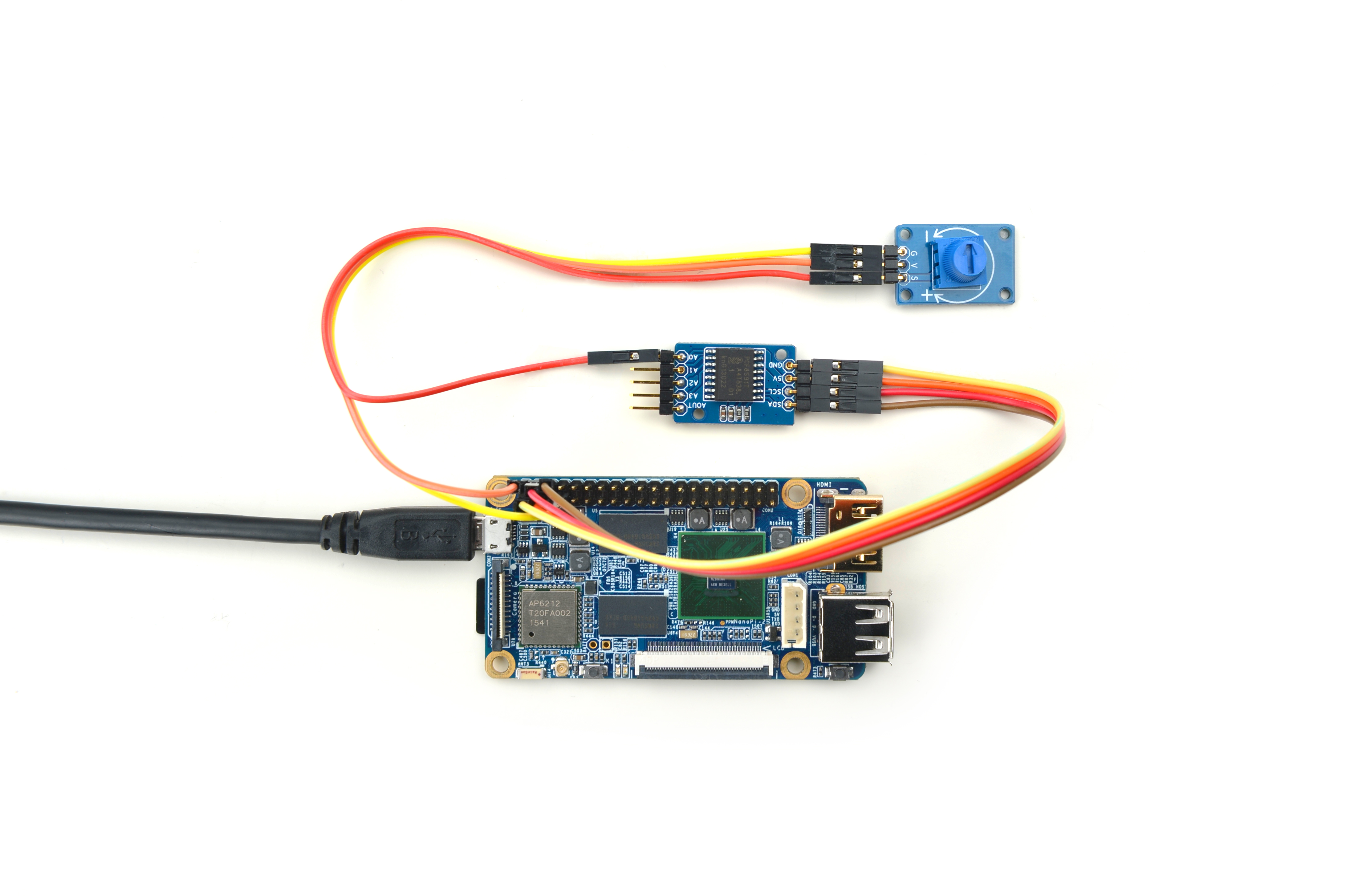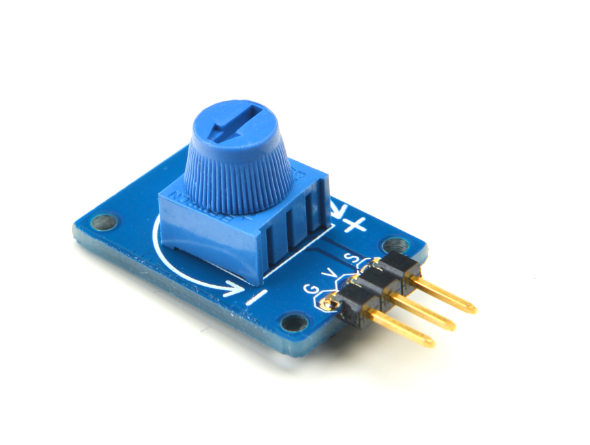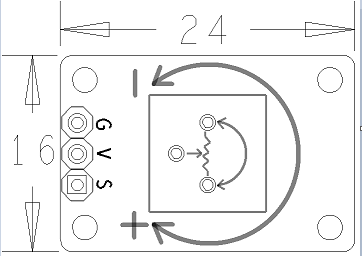Difference between revisions of "Matrix - Potentiometer"
(→介绍) |
(→特性) |
||
| Line 7: | Line 7: | ||
*Output Voltage: 0 ~ Vcc | *Output Voltage: 0 ~ Vcc | ||
| − | == | + | ==Features== |
* GPIO | * GPIO | ||
| − | * | + | * Small |
| − | * 2. | + | * 2.54mm spacing pin header |
| − | * | + | * PCB Dimension(mm): 8 x 24 |
[[File:Potentiometer.png | frameless|400px|Potentiometer_PCB]] | [[File:Potentiometer.png | frameless|400px|Potentiometer_PCB]] | ||
| − | * | + | * Pin Description: |
{| class="wikitable" | {| class="wikitable" | ||
|- | |- | ||
| − | | | + | |Pin || Description |
|- | |- | ||
| − | |S || | + | |S || Analog GPIO |
|- | |- | ||
| − | |V || | + | |V || Supply Voltage 5V |
|- | |- | ||
| − | |G || | + | |G || Ground |
|} | |} | ||
Revision as of 11:14, 6 January 2016
English
Contents
1 Introduction
- The Matrix-Potentiometer module is a Potentiometer module. It can be used in audio control, motion control, transducers, computation and etc.
- 3 Pin 2.54mm spacing pin header, V is supply voltage, G is ground and S is output analog signal. Users can convert output analog signals to digital signals via ADC conversion.
- Output Voltage: 0 ~ Vcc
2 Features
- GPIO
- Small
- 2.54mm spacing pin header
- PCB Dimension(mm): 8 x 24
- Pin Description:
| Pin | Description |
| S | Analog GPIO |
| V | Supply Voltage 5V |
| G | Ground |
3 工作原理
- 电位器是一种具有三个端子,其中有两个固定接点与一个滑动接点,可经由滑动而改变滑动端与两个固定端间电阻值的电子零件,属于被动元件,使用时可形成不同的分压比率,改变滑动点的电位。
- 模块主要器件是一个电位器,通过改变接入电路部分电阻线的长度来改变接入部分的电阻值,从而改变输出端的分压。
4 下载Matrix源码
Matrix配件相关的代码是完全开源的,统一由一个仓库进行管理:https://github.com/friendlyarm/matrix.git
该仓库里不同的分支代表着Matrix配件所支持的不同开发板。
- nanopi分支用于支持NanoPi;
- nanopi2分支用于支持NanoPi 2;
- tiny4412分支用于支持Tiny4412;
- raspberrypi分支用于支持RaspberryPi;
在主机PC上安装git,以Ubuntu14.04为例
$ sudo apt-get install git
克隆Matrix配件代码仓库
$ git clone https://github.com/friendlyarm/matrix.git
克隆完成后会得到一个名为matrix的目录,里面存放着所有Matrix配件的代码。
5 与NanoPi 2连接使用
5.1 硬件连接
参考下图连接模块Matrix-Potentiometer和NanoPi 2:

连接说明:
| Matrix-Analog_to_Digital_Converter | NanoPi 2 |
| SDA | Pin3 |
| SCL | Pin5 |
| 5V | Pin4 |
| GND | Pin6 |
| Matrix-Potentiometer | |
| GND | NanoPi 2 Pin9 |
| 5V | NanoPi 2 Pin2 |
| S | Matrix-Analog_to_Digital_Converter A0 |
电位器输出的是模拟信号,需要使用ADC转换模块Matrix-Analog_to_Digital_Converter将模拟信号转换为数字信号。
先把模块Matrix-Analog_to_Digital_Converter接在NanoPi 2上,然后将模块Matrix-Potentiometer的S引脚接在ADC转换模块的A0引脚。
关于模块Matrix-Analog_to_Digital_Converter可参考wiki:Matrix-Analog_to_Digital_Converter。
5.2 编译测试程序
进入Matrix代码仓库,切换到nanopi2分支
$ cd matrix $ git checkout nanopi2
编译Matrix配件代码
$ make CROSS_COMPILE=arm-linux- clean $ make CROSS_COMPILE=arm-linux- $ make CROSS_COMPILE=arm-linux- install
注意:请确保你的主机PC当前使用的交叉编译器为NanoPi 2配套的arm-linux-gcc-4.9.3。
编译成功后库文件位于install/lib目录下,而测试程序则位于install/usr/bin目录下,模块Matrix-Potentiometer对应的测试程序为matrix-adc。
硬件驱动模块位于modules目录下,对应的驱动源码都包含在在NanoPi 2的Linux内核仓库里:https://github.com/friendlyarm/linux-3.4.y.git
5.3 运行测试程序
将带有Debian系统的SD卡插入一台运行Linux的电脑,可以挂载SD卡上的boot和rootfs分区。
假设rootfs分区的挂载路径为/media/rootfs,执行以下命令将Matrix的硬件驱动、库文件和测试程序拷贝到NanoPi 2的文件系统上。
$ cp modules /media/rootfs/ -r $ cp install/lib/* /media/rootfs/lib/ -d $ cp install/usr/bin/* /media/rootfs/usr/bin/
将SD卡重新插入NanoPi 2,上电启动,在Debian的shell终端中执行以下命令加载硬件驱动。
$ cd /modules $ insmod pcf8591.ko
运行模块Matrix-Potentiometer的测试程序。
$ matrix-adc5.4 代码展示
int main(int argc, char ** argv) { int i = 0; int value = 0; int channel = 0; if (argc == 2) { channel = atoi(argv[1]); } for (i=0; i<ADC_READ_TIMES; i++) { if (pcf8591Read(channel, &value) != -1) { printf("channel%d value=%d\n", channel, value); } else { printf("Fail to get channel%d value\n", channel); } usleep(10000); } return 0; }


